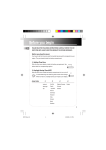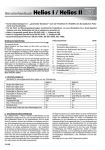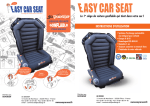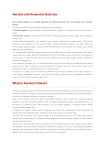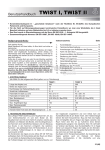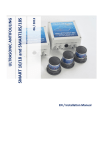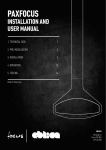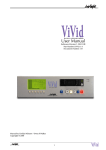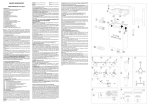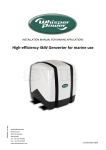Download handbook
Transcript
Owner’s Manual Palava VERSION 01/10/04 GB • Construction Category D – “Internal Waterways” under Directive No. 94/25/EC of the European Parliament and the European Committee. • A recreational vessel designed for use on internal waterways with an expected wind strength reaching Grade 4 on the Beaufort Scale inclusive and a determining wave height of up to 0.5 m. • The boat has been manufactured in compliance with the EN ISO 6185 - 1 Standard, Category IIIA. • Related standards: EN ISO 10087, EN ISO 10240, ISO 14945. Table of Contents: 1. Table of Specifications _________________ Page 9 Dear Customer, This manual will help you to easily and safely master your vessel. It contains a detailed description of the vessel, the supplied or built-in equipment, its sets as well as information about its control and maintenance. Please read it carefully, thereby getting to know the boat before actually using it. If this is your first vessel or you have changed the type of vessel and do not know this type well, please get acquainted with its maintenance and control prior to your first individual use of the vessel so that it is safe and comfortable. Your dealer or the National Yacht Federation or club will recommend you appropriate training courses or qualified instructors. Please store this manual in a safe place and hand it over to the new owner should you sell the vessel. 2. Technical Description _________________________ 9 3. Inflation Instructions __________________________ 10 4. Using the Canoe _____________________________ 10 5. Storage of the Canoe_________________________ 11 6. Using the Inflation/Safety Relief Valves ________ 11 7. Treatment and Storage _______________________ 11 8. Guarantee Conditions ________________________ 12 9. Boat Repairs _________________________________ 12 10. Product Disposal Method _____________________ 12 11. Packaging Disposal Method __________________ 12 12. Type Parameters Tag _________________________ 12 13. Safety Caution ________________________________ 12 1. TABLE OF SPECIFICATIONS (Dimensions When Inflated) Palava Length (cm) 380 Width (cm) 90 Sidewall cylinder diameter (cm) Number of air chambers Dimensions – packed in carry bag (cm) Dimensions – packed in cardboard (cm) Maximum operational pressure 29 3+2 55x40x25 65x40x25 0.02 MPa [ 0.2 Bar / 3 PSI ] Weight (kg) 20 Load (kg) 240 Maximum number of people 2+1 Draught (cm) 15 The highest anchor above surface (cm) 40 2. TECHNICAL DESCRIPTION The canoe has five inflatable chambers. The three major chambers, two sidewall cylinders and floor are equipped with valves which enable inflation and deflation of the canoe, pressure regulation in the chambers by releasing the valves, and the measurement of pressure in the chambers. The floor of the canoe is also equipped with a safety relief valve. The two remaining chambers, the upper decks, are equipped with simple rubber valves with plug stops. The canoe is equipped with two seats and a central fixture for a third seat designed for children. The third seat is not included in the accessory kit but can be ordered as a spare part. Fixation thigh-straps are laced through the fixtures on the floor and the seat fixtures for all people in the canoe. Valves are located in the front part of the cylinders and the floor. Fixation holes for the peripheral rope or a tilt (not included in the accessory kit of the canoe) are cut in the upper seal of the cylinders. The bow and the stern include handles to carry the canoe. The canoe comes packed in an 80-liter waterproof backpack. The accessory kit also includes a foam sponge in a mesh bag and a gluing set containing adhesive, patches, sandpaper, valve adapter, two plug stops for valves and repair instructions. 9 (44) A 6 5 4 1 2 3. INFLATION INSTRUCTIONS Prior to inflation, lay out the canoe and install the seats. Lace the right side of the seat (1) and the fixation thighstrap (2) to the seat fixture (3) using the enclosed rope. Secure both ends of the rope by simple knots at the bottom. Follow the instructions in Picture B. Lace the opposite side of the seat with the fixation strap clip in the same manner. Repeat this procedure with the other seat. Prior to inflating the canoe, check the state of the valves. Set the valves to the Closed position by gently pressing down on the valve-stems and turning them, and then releasing your finger so that the valve-stems „seat“ themselves in their upper position. A piston pump with valve adapter is best suited for inflation (the valve adapter is included in the gluing set). Inflate individual air chambers as follows: First inflate the floor (4), then both sidewall cylinders (5) and finally the decks (6). After inflation, secure all valves with their valve caps. To set the correct operational pressures in the air chambers, use a manometer with the appropriate reduction. B 2 3 1 ATTENTION The maximum operational pressure in the air chambers is 0.02 MPa. If the ambient temperature increases (e.g. owing to sunlight), the pressure in the air chambers of the boat can rise rapidly. We rec10 (44) 3 B 1 ommend releasing some air from all air chambers of the boat after pulling it out of the water. Possible destruction of the air chambers will thus be prevented. However, do not forget to continuously monitor the air pressure in the chambers afterwards, too. 4. USING THE CANOE The PALAVA 380 two-seat inflatable canoe is designed for recreational use and water tourism. When used on calm waters, the canoe can be additionally equipped with a child seat. Whenever the canoe is used on waterways, Waterway Traffic Rules have to be observed. Operation of the PALAVA canoe does not require any licence provided that the people who operate the canoe know the techniques of small boat operation within the scope necessary for its operation, as well as the valid navigation rules of the particular country. The design of the Palava 380 canoe enables it to be used on wild water up to Difficulty Grade WW3 or for water-based tourism activities on calm rivers. The canoe’s advantages are good stability, manoeuvrability, compactness, easy transport and a long lifetime. The canoe is propelled by two canoeists sitting on the seats. All people in the canoe have to wear flotation lifejackets. When using the canoe on wild water, canoeists are on their knees, supported by the seats; their thighs are fixed by thigh-straps with a safety clip which enable safe abandonment of an overturned canoe. The canoe can be equipped with a tilt that prevents water from entering the canoe while passing through rapids. Use canoe paddles. ATTENTION Prior to every use of the boat, check whether it is necessary to observe any special regulations, restrictions or rules connected with the river, surface of water or area in which you aim to operate. The boat is not designed to be towed behind motorboats, nor may it be towed otherwise, dragged or in any way stressed unusually. Sharp edged and pointed items carried in the boat must be safely wrapped. Place all precious items into a waterproof container and fasten it to the boat. Over time, sunlight adversely affects the rubber coating of the boat; therefore, it is advisable to store the boat in shade each time after use. CAUTION • On large surfaces of water (seas, lakes) pay attention to off-shore breezes. Currents and breezes may make it impossible to return to shore. • The Palava canoe should not be used in challenging conditions, such asIn reduced visibility (night, fog, rain). • It is necessary to adequately practise undoing the fixation thigh-straps and abandoning an overturned canoe on calm waters in advance. Characteristics of Difficulty Grade WW 3 – Hard: • Big rapids, high and irregular waves, pillows, whirlpools, medium blockage and low cascades in strongly meandering rivers or blind rivers. Subjective assumptions for riding wild waters graded WW 3: • Excellent knowledge of all basic strokes, very good control of the boat, the ability to realistically evaluate the difficulty posed and the actual state of the river’s waters, elementary knowledge of live-saving techniques in the water, swimming skills in wild waters and physical fitness. Technical equipment for riding wild waters graded WW 3: • Covered boats, boats with self-draining floor or open boats equipped with covers; flotation life-jackets with a minimum displacement of 7.5 kg, helmets, protective clothes against cold (neoprene) and safety instruments. ATTENTION Pay great attention to your choice of flotation lifejacket. The flotation life-jacket should have a tag bearing details of its flotation capabilities and safety certification. 5. STORAGE OF THE CANOE Prior to folding the canoe, unlace the seats, clean the canoe and dry it. Deflate both decks by pulling out the plug stops. By pressing down on the valve-stems and turning them, open the valves and release the air from the major chambers. Deflation may be quickened by rolling up the canoe in the direction of the valves. No sharp objects should remain in the canoe. Straighten the deflated boat on even ground and fold the sidewall cylinders towards the centre in such manner that they do not overlap the ground plan of the floor. Then roll up the canoe from the stern towards the valves in such manner that will enable you to comfortably insert the folded canoe into the backpack. Expel air from the backpack, roll up the insertion end and fasten it with clips. 6. USING THE INFLATION/SAFETY RELIEF VALVES The GUMOTEX filling valves enables inflation of the boat by means of a piston pump or a foot pump, using the appropriate adapter to fit the hose end to the valve opening. Opening the valves Remove the valve caps by turning them in the anticlockwise direction. Press down on the orange valve- stem, gently rotate and release your finger so that the stem „seats“ itself in the lower position. Repeat this step if necessary. Closing the valves Press down on the orange valve-stem and gently rotate it. When you release your finger, the spring-loaded stem should pop up and stay in the upper position. Mount the valve cap and gently tighten it in the clockwise direction. Opening the valves air air Closing the valves ATTENTION When using the boat, always seal the valves with their valve caps. This will keep dirt out of the valves. Dirt can cause leaky valve seals. 7. TREATMENT AND STORAGE The rubber surface coating of the boat is sensitive to oils, gasoline, toluene, acetone, kerosene and similar thinning agents. Prior to storing a dirty boat, wash it down with warm soapy water. Rinse the boat with fresh water after using the boat in seawater. It is recommended to check the state of the inflation valves and the safety relief valves. If a valve is not air-tight, it is possible to unscrew the valve body from the boat with the use of a special valve-key and clean its membrane with a strong jet of water or compressed air. Prior to storage, it is recommended to rub the surface of the boat with an agent intended for the treatment of such surfaces, which has cleaning properties, and which impregnates the material to prevent further dirtying, or which is capable of forming a protective UV-filter. Never use agents containing silicon when treating your boat. Store the cleaned and dried boat in a dark, dry place at temperatures of between 10–25 °C. During long-term storage, it is recommended to inflate the boat for 24 hours from time to time to avoid fatiguing the fold lines. It is also recommended to have the boat serviced by the manufacturer’s authorized service station at least once every two or three years. Proper care and treatment of the boat will increase its service life. 11 (44) 8. GUARANTEE CONDITIONS The guarantee period is 24 months and is calculated from the date of sale. The producer provides cost-free repairs or replacement of faulty components for material faults or production faults. 9. BOAT REPAIRS You can easily repair a damaged boat yourselves by means of the accompanying gluing set. Gluing: • mark out the damaged area on the boat and choose an appropriately sized patch; • the surfaces of both patch and place to be glued must be clean, dry and without traces of old glue; • sandpaper the patch and the damaged area and degrease the area to be glued by using acetone or gasoline; • spread a thin layer of glue on both surfaces to be glued and repeat this step once the first layer has dried; • after the second layer has dried, press the patch firmly on the damaged place, weigh down or use a rolling pin on a flat surface. For minor repairs (punctures), it is possible to re-inflate the boat and continue using it after waiting for approx. 30 minutes; after more serious repairs, you should wait for 24 hours before using the repaired boat. Complicated repairs should be performed by the manufacturer or at authorized service stations. Guarantee repairs and post-guarantee repairs are provided by the manufacturer: GUMOTEX, a. s. MládeÏnická 3 A, ã. p. 3062 690 75 Bfieclav Czech Republic 10. PRODUCT DISPOSAL METHOD The product should be disposed of at municipal waste disposal sites. 11. PACKAGING DISPOSAL METHOD Cardboard – recycle as the indicated symbol directs. PE-LD plastic wrap (low-density branched polyethylene) – recycle as the indicated symbol directs. 13. SAFETY CAUTION Boating sports can be very dangerous and physically demanding. The user of this product must realise that boating sports activities can cause serious injuries or even death. When using this product, follow the safety standards specified below: • Learn how to use this type of boat. • Undergo certified first-aid training, obtain a first-aid kit and always carry rescue/safety equipment with you. • Always use certified flotation life-jackets. • Always wear an appropriate helmet if the specific conditions require it; wear proper clothes according to the specific weather conditions; cold water and/or cold weather can cause hypothermia. • Prior to every use, check your equipment to make sure it is not damaged. • Never use the boat on water alone. • Never use the boat on rivers with apparently high water level. • Pay attention to inspecting the water level, dangerous currents and weather changes; when on the sea, pay attention to changes in the incoming/outgoing tide. • Inspect all unknown sections of rivers on which you want to use the boat; carry the boat over all places where it is necessary. • Do not overestimate your abilities when on the water; be careful. • Prior to setting off on the water, consult your state of health with your doctor. • Follow the manufacturer’s recommendations concerning the use of this product. • Prior to using this product, never drink any alcohol or use any drugs. • If other boat accessories are available, use only the materials approved by the manufacturer. • Prior to using this product, read the User’s Manual. The user of this product must master basic boating skills and be aware of the risks related to this kind of sport. The Guarantee Certificate is attached to this manual. 12. TYPE PARAMETERS TAG Each boat is provided with its own Type Parameters Tag which displays the most important technical parameters. Please follow these values. Above all, do not overload the boat and maintain the recommended maximum pressures in the air chambers. Picture and explanation of the symbols used – see Page 42. 12 (44) Palava 380 EN ISO 6185 -1, IIIA Design cat. D 0,020 MPa [ 0,20 bar ] [ 3,00 PSI ] 2 1 240 kg [ 530 lbs ] WW 3 Explanation of the symbols used: GB maximum operational pressure maximum number of people maximum load





